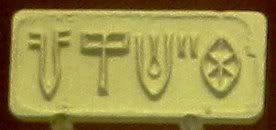 |
This picture shows a Harappan seal with five inscriptions or characters, which have been undeciphered. In fact there are many decipherments, but no scholarly consensus. One of the disputes is at a fundamental level: do these markings belong to a language or were the Harappans illiterate?
Finally, in a breaking news moment, we have an answer.
Now, a team of Indian scientists reports in Friday’s issue of Science journal that the Indus script has a structured sign system showing features of a formal language. Using mathematical and computational tools, researchers show that the script has well-defined signs, which begin and end texts, with strong correlations in the order in which the signs appear.[Scientists inch closer to cracking Indus Valley script – Home – livemint.com]
According to Asko Parpola, an expert on Indus seals
“It’s a useful paper,” said University of Helsinki archaeologist Asko Parpola, an authority on Indus scripts, “but it doesn’t really further our understanding of the script.”
Parpola said the primary obstacle confronting decipherers of fragmentary Indus scripts — the difficulty of testing their hypotheses — remains unchanged. [Artificial Intelligence Cracks 4,000-Year-Old Mystery | Wired Science from Wired.com]
Also
J. Mark Kenoyer, a linguist at the University of Wisconsin-Madison, says Rao’s paper is worth publishing, but time will tell if the technique sheds light on the nature of Indus script.
“At present they are lumping more than 700 years of writing into one data set,” he says. “I am actually going to be working with them on the revised analysis, and we will see how similar or different it is from the current results.”[Scholars at odds over mysterious Indus script – life – 23 April 2009 – New Scientist]
Additional Reading:
